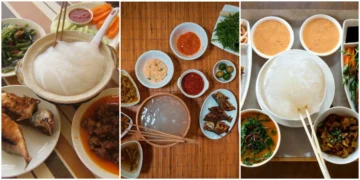Costa Rica–a small Central American nation known for its wealth of biodiversity, friendly “pura vida” spirit, and vibrant culinary traditions–has given rise to the best food of Costa Rica: Gallo Pinto. Translating as “spotted rooster” in Spanish, Gallo Pinto stands as an embodiment of Costa Rican culinary identity and national pride; serving generations of Costa Ricans across generations with its delicious mix of hearty staples combined with zesty fresh flavors that encapsulate Costa Rican cooking ethos. Gallo Pinto stands as a true testament to the simplicity and inventiveness that characterize Costa Rican cooking!
Why Gallo Pinto Is the Ideal Choice?

Gallo Pinto has earned its place as one of the finest foods in Costa Rica through its remarkable ability to blend complex flavors harmoniously into a single satisfying plate. At first glance, the dish may appear unassuming–an unassuming mix of white rice combined with red or black beans–but each spoonful unveils layers of savory, tangy, and subtly sweet notes that combine perfectly in harmony. Visual “spots” created by beans against rice are said to resemble rooster feathers hence its playful name! More than just a filling meal, Gallo Pinto represents a “pura vida” lifestyle–embracing simplicity, community spirit, and natural bounty.
Gallo Pinto, traditionally enjoyed as a breakfast dish, can also be found throughout the day as part of any meal plan. Its humble ingredients and straightforward preparation belie its complex flavors when all components combine – be it at a family kitchen table, bustling local soda (small eatery), or roadside stall – Gallo Pinto not only fills appetites but also brings Costa Ricans together and connects them with their cultural roots.
Ingredients of Costa Rica
- Rice: Long-grain white rice serves as an ideal neutral canvas that absorbs all of the flavors in its surroundings. When prepared properly, it should become fluffy with each grain identifiable yet fully integrated into its surroundings.
- Beans: Red (or sometimes black) beans are the second star of any rice dish. Pre-cooked until tender, they’re then lightly simmered with the rest of the dish for an earthy flavor and soft texture that creates a delicious contrast with its crunchy textures and soft centers.
- Salsa Lizano: No discussion of Gallo Pinto would be complete without mentioning Salsa Lizano–an irresistibly delicious sauce unique to Costa Rica made up of vegetables, spices, and tropical fruits–that gives the dish its distinctive, vibrant taste. This sauce adds dimension and vibrancy that sets Gallo Pinto apart.
- Aromatics: Sauteed onions and garlic create an aromatic base, releasing their natural sugars and flavor compounds for maximum depth in any rice and bean dish. These aromatics provide essential depth to an otherwise mundane dish.
- Herbs and Seasonings: Fresh cilantro and occasionally lime add an acidic zing. Salt and pepper should only be added sparingly so as not to overwhelm the natural flavors in your dish.
- Optional Additions: In some family recipes, additional vegetables like bell peppers or diced tomatoes may be added for extra texture and color, highlighting Costa Rica’s fertile land even further.
Prepare of Gallo Pinto (Best Food of Costa Rica)

- Crafting the Perfect Gallo Pinto Mastering the art of Gallo Pinto preparation requires generations-old family traditions passed from generation to generation in Costa Rican households. While regional differences exist when it comes to recipes and methods used, generally speaking, they adhere to an age-old method emphasizing simplicity, care, and fresh local ingredients as part of its traditional method. Here is a step-by-step overview:
- Cooking Rice and Beans Separately: Gallo Pinto’s foundation rests upon first separately cooking its two components – usually rice until just fluffy while beans, often soaked overnight to ensure even cooking, are simmered until tender. This initial stage is essential as it ensures both parts are prepared perfectly before being combined together in the final dish.
- Simmering Aromatics: In a large and heavy skillet, use just enough oil to saute onions and garlic finely chopped until they become soft and translucent. This step is essential in unlocking all their natural flavors and sweetness, providing the foundation that binds rice and beans together into one delicious dish!
- Once onions and garlic have been sauteed, a generous drizzle of Salsa Lizano sauce should be added – this step sets Costa Rican Gallo Pinto apart from other rice and bean dishes! The salsa adds both unique tanginess and complexity that enhance the overall flavor profile of this classic rice-and-bean dish.
- Combining Rice and Beans: After pre-cooking both ingredients separately, combine them in the skillet along with aromatics and sauce before gently mixing together with each other, making sure every grain of rice and every bean are evenly covered by this flavorful mix. Finally, allow this dish to heat through and allow the flavors to combine – usually over low to medium heat for several minutes – so all flavors may blend.
What Makes Gallo Pinto Special?
Gallo Pinto stands out as an exceptional dish by using two simple ingredients–rice and beans–to craft something far greater than its parts. Unlike more complex dishes, its beauty lies in its ease and versatility; Salsa Lizano sauce (popular among Costa Rican cuisine) adds both tartiness and sweet nectar that immediately marks it as Gallo Pinto.
Gallo Pinto is an iconic dish representing Costa Rican culture and nature, reflecting both their cultural and natural history. This staple breakfast, lunch, and dinner dish embodies its namesake lifestyle of living simply and appreciating natural resources. As its role as a staple dish speaks volumes of its versatile appeal- whether eaten in humble homes or bustling local sodas- Gallo Pinto symbolizes resourcefulness and warmth that are hallmarks of Costa Rican society.
History of Gallo Pinto (Best Food Costa Rica)

Gallo Pinto can be traced to an amalgamation of indigenous culinary practices and Spanish colonial influences. Rice and beans were staples for local residents due to Costa Rica’s fertile soils and temperate climate, and over time these humble ingredients became further enhanced with spices and sauces from different local areas, giving rise to what has now become an iconic national dish.
Gallo Pinto began life in rural Costa Rican communities as an energy-rich lunch for laborers working the fields, with its nutritious composition providing energy-rich sustenance. Over time, due to urbanization and culinary traditions spreading, it became more widely appreciated, becoming a beloved national comfort food and celebrated not only for its delicious taste.
Costa Rica Offers Delicious Dishes
- Casado: It features rice, beans, salad, plantains, and meat from which one may select.
- Olla de Carne: A comforting beef stew featuring vegetables like yuca, carrots, and potatoes.
- Ceviche: Fresh fish marinated in citrus juices with onions, cilantro, and a hint of chili.
- Tamales: Corn dough stuffed with meats, vegetables, and spices wrapped in banana leaves before being steamed offers a glimpse of traditional rural cooking.
- Chifrijo: Chifrijo is a traditional bar snack from Costa Rica made up of rice, beans, pork, and Pico de Gallo.










Discussion about this post